
Ref: z2708353m
With the new 0,18 µm CMOS platform for 2,4 GHz wireless communication, nRF24XX, Nordic VLSI was able to release a family of four new RF devices in less than six months. The new platform sets new standards for wireless communication in the global 2,4 GHz ISM frequency band with extremely small packages, few external components, low current drain, and operation down to 1,9 V over the industrial temperature range -40 to +85°C. The new RF circuits have very competitive features ranging from protocol pre-processing - ShockBurst as well as an 8051MCU core, 9-channel 12 bit ADC, PWM, timers and a dual receive - all resulting in a very low Bill of Material cost. The nRF24XX family is supplied in packages from 4 x 4 mm to 6 x 6 mm, with a crystal and a resistor required externally to make up a complete radio.
0,18 µm CMOS brings new levels of functionality
Nordic made the decision to migrate to the 0,18 µm pure CMOS fabrication process for the nRF24xx family, a move which competitors are struggling to match. Nordic had previous project experience with this technology and its clear benefits were brought to bear during the device's concept. The level of integration now employed means operational voltages of 1,9 V are achievable and current demands are reduced accordingly, typically 13 mA at full output power and a mere 12 µA in stand-by mode, equalling or bettering any comparable device available. The nRF24xx devices have been designed to fit effortlessly into a close-proximity environment and with 128 (1 Mbps each) channels programmable and a dynamic range even exceeding that of the sensitivity range (>95 dBm @ 250 kbps & >85 dBm @ 1 Mbps) they are extremely robust in a close proximity situation.
Device uniqueness
The real beauty of this fabrication evolution is the opportunities it has opened up for implementation of added analog and digital functionality 'on-chip'. A number of unique features have been incorporated into the available real estate that has become available on the silicon. Two radical core functionality developments have been made in the nRF24xx devices: ShockBurst and DuoCeiver.
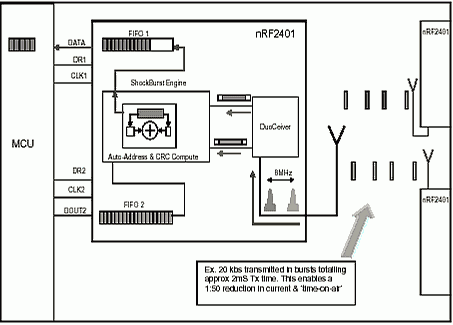
ShockBurst incorporates an integrated FIFO register for temporary storage of data in the pre-transmission and post-reception stages. This FIFO is controlled by an SPI interface, thus enabling an MCU to clock data in/out at a speed that is appropriate to its capacity. ShockBurst is enhanced further with on-chip auto-address resolution and CRC implemented in hardware. This functionality has the great advantage of removing message verification from the MCU's list of duties, leaving the micro to remove data only when the nRF2401 informs it that an appropriate packet has arrived. This is a key enabler in the integration of typical 2,4 GHz band data-rates (1 Mbps) and ultra low-cost MCUs which may be operating at, say, 20 kbps. It allows the applications typically using less than 1 Mbps to transmit at 1 Mbps rates with packet bursts, thus drastically reducing current consumption and minimising time-on-air by factors of 100 or more. DuoCeiver allows a single receiver architecture to receive full data rates of up to 1 Mbps simultaneously on each channel. The DuoCeiver function operates without the need to use any multiplexing schemes, and enables full, simultaneous reception of 1 Mbps datarates on dual channels.
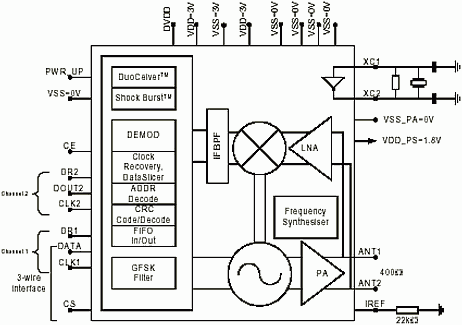
Broadening the application scope
The nRF2401 is currently causing a storm in the wireless keyboard and mouse arena with its feature set and performance. This is not such a surprise as during the conceptual stage this market was defined as a key target for the device's implementation. The ShockBurst and DuoCeiver features are a partial reflection of this, however, the embedded functions are finding interesting and novel applications in other areas also. The DuoCeiver and auto-address resolution ability can be used in applications that require the ability to individually locate and communicate from node to node, and also need to broadcast messages to all nodes in the network. This is very simply implemented on the nRF2401 with the assigning of a common address ID to the second channel. This is a key feature for the 'intelligent-home' type of application.
Within this market many OEMs have grown tired of the wait for the final arrival of Zigbee, and other such standardised devices which can also be a straightjacket in development of products. The Zigbee standard is currently undergoing ratification and with master node protocol stacks of 64K or more is appearing too top-heavy for many application developers. In this style of application Bluetooth solutions are often regarded as too complex, expensive and current demanding thus putting them out of this current market and place their appeal more as a gateway to a proprietary network than as the network topology itself. The Nordic nRF2401 could operate from a 280 mAh button-cell operating with a typical 1 s update of 256 bits of data for longer than five years.
Application areas as diverse as mobile intelligent sports kit, smart-home, tyre-pressure, automation positioning systems and MP3 systems are seeing project development with the nRF24xx due to its low power requirements and exclusive feature set.
Global products in the 2,4 GHz environment
With the utilisation of the 433 and 868 MHz ISM band having been around for some years now, some developers are looking to the 2,4 GHz band for new and existing application areas. The 2,4 GHz band also has the added appeal of being globally available unlike ISM bands at 433/868/915 MHz etc. This enables singular development costs as opposed to having several hardware platforms to maintain and reduces the logistical problems that arise when addressing differing geographical regulations for the other ISM bands.
The 2,4 GHz band has been seen as a 'local' communications medium with typical ranges of 15-30 m indoors. The nRF2401 achieves over 220 m line-of-sight at 0 dBm, and with the addition of a simple PA device, up to 100 mA is allowed by regulatory bodies with the implementation of a frequency-hopping scheme. The nRF2401 is fully capable of performing these tasks with channel switching times of only 200 µs.
One of the major challenges seen by engineers in this band is the ability of their products to communicate in a band which is widely recognised as containing both W-LAN and Bluetooth also.

Nordic engineers have found that the interference that is created by these technologies is minimal and only in the most extreme situations is communication compromised. W-LAN whilst operating within the same band is a sophisticated technology utilising CSMA/CD for medium utilisation before transmissions. The vast majority of W-LAN also implements the direct sequence spread spectrum (DSSS) technique of modulation. This method of modulating the signal uses 'chipping' codes in the modulation which not only spreads the output power over a number of channels (typically 22) but also inherently resists narrowband interference, therefore the lower local channel power is beneficial to the nRF2401 and nRF2401 transmissions are attenuated by the W-LAN receiver.
The nRF24xx modulation and channel scheme is the same as those for Bluetooth but tests have shown that given the width of the frequency band and the very short nature of transmission, collisions have not been a major problem even in a heavily populated Bluetooth environment (>8 devices around nRF24xx).
Layout headaches are over
Historically, RF design-in has left many developers fearful over stories of ultra critical attention to layout considerations, component criticality and effects of noise and interference from other parts of the system design. This has for a large part been true for all RF designs. The level of on-chip integration has until now fallen short of areas such as VCO inductors, IF filtering and PLL filtering - all of which are extremely critical areas for any radio's operation. The placement of VCO and PLL components externally, meant they were susceptible to noise, and inappropriate placement or choice of component could render a radio completely inoperable. The nRF24xx family has practically eliminated this issue with the on-chip integration of all inductors and filter networks. Indeed, the only external components required now are a crystal reference and a reference resistor. This is a crucial step forward in RF design-in for general application developers who may not have extensive in-house RF design expertise. A full set of layout designs exists for the nRF24xx family including integrated printed circuit antennas. Wireless nRF24xx USB, wireless mouse and hands-free headsets are among a range of reference designs being released to developers using thenRF24xx to simplify the design task yet further.
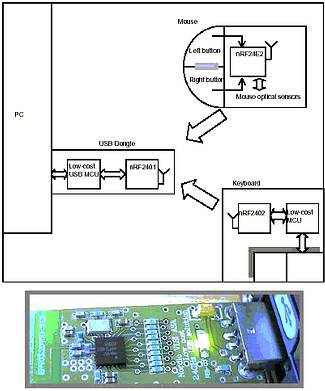
It is all about reducing the Bill of Material
As has been shown in the previous sections, the innovative built in features of the nRF2401 transceiver and the nRF2402 transmitter have a great effect on the workload which the external microcontroller has to handle. Furthermore, the two components have integrated all the filters, inductors and capacitors seen with normal wireless components - how can the integration be moved one step up from this?
Clearly with 0,18 µm CMOS there are great advantages in including digital logic, as this can be done with little increase in size. The latest offering from Nordic, the nRF24E1 and nRF24E2, 2,4 GHz transceiver and transmitter reflect this. The new 2,4 GHz components come with an embedded 8051 MCU, a 9-channel 12 bit ADC, pulse width modulator (PWM), RC oscillator, digital I/O, timers, UART and other peripherals, providing the user with a complete 'System On Chip' running at 2,4 GHz, delivered in a 6 x 6 mm 36 pin QFN package.
Each component inside the nRF24E1/E2 is in itself leading with respect to performance and current consumption. The on chip 8051 MCU consumes 3 mA @16 MHz, and the ADC runs on as little as 0,9 mA. The system as a whole can be put into a 2 µA power down mode with wakeup on external pin or from the on chip wake up timer or by a watch dog reset.
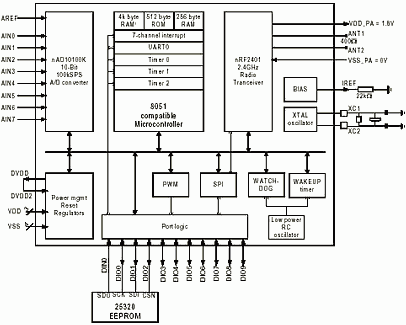
The nRF24xx family has already been incorporated in a number of new and existing wireless global applications such as sensor, remote control, mouse, game controllers, tyre pressure sensors and intelligent sports equipment applications. The level of integration has seen the device being incorporated into a growing number of industrial designs also due to the very small footprint for a complete radio and its EMI robustness. The low power level requirements, unique feature set coupled with the appeal of a global frequency band has made the nRF24xx devices a first in many applications. The nRF24Ex family has taken the level of integration yet further and provide a complete system on a device for the applications mentioned. The system cost and complexity is reduced significantly compared to any other technology or frequency available in the market today.
An overview of currently available nRF24XX components is included below.
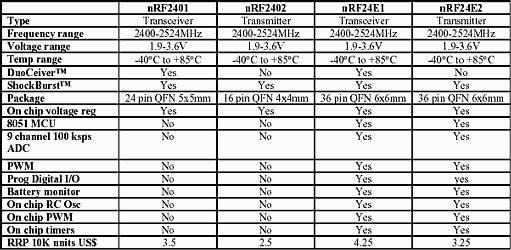
| Tel: | +27 21 555 8400 |
| Email: | [email protected] |
| www: | www.rfdesign.co.za |
| Articles: | More information and articles about RF Design |

© Technews Publishing (Pty) Ltd | All Rights Reserved